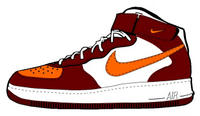 Nike's Air Force 1, introduced in the '80s, still grabs attention -- and huge margins
Nike's Air Force 1, introduced in the '80s, still grabs attention -- and huge marginsStanley Holmes
BusinessWeek.com
Once the word hits the street, hundreds of teens start lining up at stores. So strong is demand that new releases happen only on weekends -- so kids won't skip school. When the doors open, they sell out in hours. Tickets for the current Eminem tour? The new iPod music player? Nope. We're talking about a basic basketball sneaker, Nike Inc.'s Air Force 1.
Launched in 1982, when Ronald Reagan was in the White House, the sneaker is almost pathetically low-tech. Yet the Air Force 1 remains the definition of urban cool. And while Nike Shox runners, Air Jordans, and the Cole Haan and Converse brands helped drive record earnings of $1.2 billion on sales of $13.7 billion in the fiscal year ended June 27, the AF1 played a big role, too, helping Nike reach No. 48 on the BusinessWeek 50 list of top corporate performers. AF1 racked up an estimated $1 billion in sales and generated profit margins of 70%, say analysts -- double that of other hit sneakers. Says Tashala Spellman, a 16-year-old AF1 devotee: "I like the style." She'd better: Spellman owns 10 pairs.
How do you keep a basic sneaker hot for a quarter-century? Nike's genius is that it has managed to market a classic without alienating teens. At the same time, Nike creates consumer longing by keeping supplies tight and releasing collectible versions with minimal hype. "Air Force 1 is maybe the most dominant basketball franchise in this industry," Gary M. DeStefano, president of Nike U.S., says. "But there's a way to keep it fresh."
The Air Force 1 hit the basketball courts and urban playgrounds in the '80s and quickly caught on with black youth, thanks to basketball star endorser Charles Barkley. But soon Nike began building mystique -- eschewing regular marketing channels even as it restricted supply. AF1 advertising is minimal today. Mostly, Nike lets the customers -- and the rappers -- do the talking. In 2002, for example, hip-hop's Nelly rapped about "my Air Force 1s" and generated a No. 1 hit. And such is the shoe's cult status that teenagers hang out at NikeTalk.com and other chat rooms to find out when the next AF1 is coming.
Every two months or so, Nike unleashes a newly tweaked shoe -- a camouflage version, say, or one timed for Mardi Gras. Each release involves roughly 350,000 to 500,000 pairs of shoes shipped nationwide, and each store gets about 25 to 30. "Nike continues to control the marketplace so diligently they create pent-up demand for the shoe," says John Shanley, analyst for Susquehanna Financial Group, an investment bank.
Analysts say retailers caught discounting Air Force 1s receive a smaller allocation the next time or none at all. And retailers are happy to play ball: After all, the Air Force 1 makes money and drives traffic. Retailers get full price for the shoe, basic versions of which sell for $85 to $100. Collectible versions, such as one designed by famed grafitti artist Mr. Cartoon, retail for $180. And the AF1 boosts demand for other Nike footwear, says Shanley. Nike's sell-through rate -- how fast a product flies off shelves in the first week -- averages 20%-plus of inventory, compared with an industry average of 10%. The sell-through rate for AF1s is 100%.
The Air Force 1 is a Nike profit machine. Shanley estimates that the company sells each pair to retailers for about $48.50 but pays just $12 to make them in Asia. Since the design has remained essentially unchanged, there are few development costs; all of the molds and lathes have been fully depreciated. And, of course, Nike no longer pays anyone to promote them. "It drives a much richer margin because it doesn't carry an endorsement fee," Shanley says.
There's no telling how long the Air Force 1 will remain hot in the faddish sneaker business. "If they ever get greedy with the Air Force 1, or if kids feel they're being manipulated, you can see a profitable business disappear in a hurry," says Jeffrey Bliss, president of sports marketer Javelin Group. Until then, take a number and stand in line, as Nelly says, "So I can get to stompin' in my Air Force 1s."
No comments:
Post a Comment